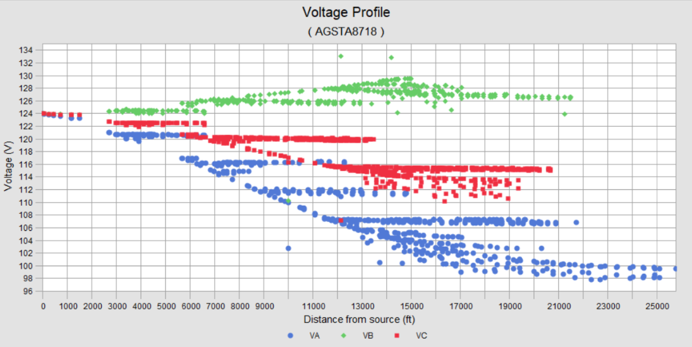Due to the compressed timeline of the IRP submission and commissioner request, the team batched the study cases into smaller areas with the most information and historical Supervisory Control and Data Acquisition (SCADA) control system data available. To maintain the highest level of accuracy, our team worked alongside the client to select 12 circuits, with the most accurate GIS models, that could be used to represent 5 topological — urban, rural, underground, overhead and mixed UG/OH. These circuits served to represent a cross section of circuits within the client’s more than 2,600 distribution circuits.

This approach provided estimated expectations that could then be extrapolated over the entire system and inform the overall IRP.
Field walkdowns were conducted for all the evaluated circuits to assist in verifying the location of existing meters as well as documenting points where unmetered loads — lights, telecommunications, broadband and more — were located on the circuits. This allowed the team to identify key locations that could impact the existing system model design.
This field reconnaissance information was then used to improve existing model quality and adjust modeling parameters to more accurately represent the conditions of each of the selected circuits.
The anticipated losses and expected operating voltage were evaluated with the addition of varying degrees of rooftop solar and electric vehicle penetration, including near- and long-term distributed energy resource potential.
To determine which changes would provide the most benefit among the allotted near- and long-term time periods, improvement scenarios were conducted using three seasonal instances. Each had a night and day instance to evaluate the annual existing, near-term and long-term PV and EV penetration conditions. The scenarios included:
- Cable upgrades for the worst-performing conductor sections (10%, 20%, 30% and 100%)
- Capacitor placement
- On Loading Tap Changing (OLTC) transformer placement
- Source tap reduction
- Circuit voltage upgrade
- Circuit voltage update and source tap reduction>
The potential savings for each scenario was extrapolated to represent the more than 2,600 existing circuits over the most accurate dollar per kilowatt loss savings. Cost estimates were developed, and recommendations were provided to indicate where voltage reduction would be applicable and for how long. This would meet the state commissioner’s request for an outline of programs.
Our findings on PV and EV penetration are to be incorporated into the IRP, so that the client can develop a proactive improvement plan based on the results. In this way, the client has evidence to justify a more accurate budget for these infrastructure improvements as more PV and EV penetrations become present on its system.
Additionally, the project overall has revealed the limited reliability the client’s system has, making it difficult to take on major changes. Due to the success of the studies, the client is now requesting additional, broader evaluations of the 12 selected circuits to provide a profile of adoption required to prepare for the future.